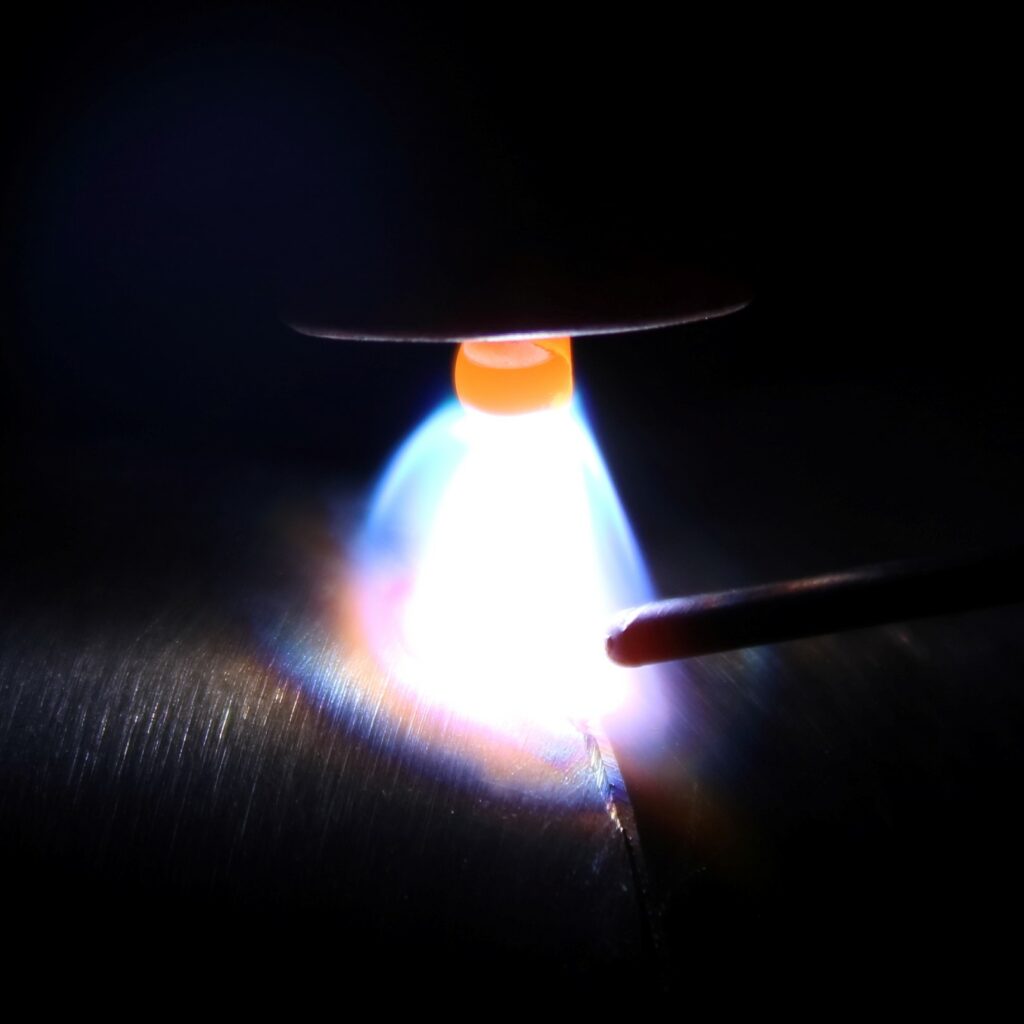Get Wet Fall 2023 – DC TIG welding on stainless steel pipe
What is TIG welding? TIG (Tungsten Inert Gas) welding is an arc welding process that uses a tungsten electrode to produce a weld. A DC (constant current) electrical power supply is used to generate immense amounts of electrical energy. This electrical energy then flows from the tungsten electrode into the piece of metal that is being welded. As this electrical energy flows, it produces a plasma as the massive electric potential ionizes the surrounding inert shielding gas (Argon). This electrical energy then flows into the metal to be welded, and heats it up to well beyond its melting point, allowing the user to effectively melt and fuse any two similar pieces of metal. Filler material is commonly used to add extra material into a weld; the skinny metal rod that you see glowing red-hot at right was the filler used for this weldment.
How TIG welding works
© weldguru.com
https://weldguru.com/tig-welding/
This was one ~100 of pictures that I took during my photography session earlier this week. My fellow rocket friend and roommate, Sam, has extensive experience in the art (and science) of welding, and volunteered a few hours of his time for me to photograph some weld arcs. I decided to go with TIG welding as this type of welding generates a very clean arc with little smoke or sparking. This would generate not only a much clearer image, but also less weld spatter and slag that could damage my camera during the shoot.
Above is the photograph that stood out the most to me. It displays a clear and colorful flowing plasma generated by the TIG torch. Note the blue and purple color of the plasma; these are the characteristic emission spectra of argon gas. One can also see a bead of molten tungsten forming at the tip of the torch, glowing yellow-hot due to the immense amount of heat generated by the weld arc. Normally, a tungsten piece would last longer than this. However, we were putting a lot of heat into the torch, causing the tungsten to heat up past its melting point and accumulate as a bead of molten metal. Tungsten has a melting point of 6200 F at STP, so you can imagine how astoundingly hot this plasma is! This is probably the hottest image you’ll see this semester :)
Camera settings:
Canon T7 Rebel, 18-55mm lens with UV filter
ISO 100
Fstop f/5.6
Shutter 1/4000
Sources: https://weldguru.com/tig-welding/
Collaborators/Co-Authors:
Paul Wingrove (welding equipment and weld shop access)
Samuel Ciesielski (welder)
Acknowledgements:
I would like to thank Paul Wingrove from the CU Physics Trades Teaching Lab for allowing us to use the PTTL shop to take these photos.
Setup: Canon T7 Rebel with a UV filter, TIG Welding Machine, and my roommate Sam which did most of the welding for this photography session.

8 Comments. Leave new
Super unique idea and really interesting result with all the colors produced from the burning chemicals. I love how you take a combustion approach to many of these projects.
The colorful plasma is very attractive! And the welding work is very cool. Thanks for the detailed explanation of the principles. I’m sure it’s definitely the hottest thing I’ve seen this semester except the sun!
This is an interesting phenomenon to capture. I admire the use of the UV filter to show the colors.
Hi Kenneth
This was a really good idea for this assignment, I wouldn’t have thought about capturing the plasma during welding.
The use of a UV filter was a good idea, especially considering you and the camera would have needed to get close enough to capture the shot.
I think a little more post-processing on the shot, enhancing the contrast and sharpness, would really help to differentiate the white and blue cones in the image.
I’d also like to mention that the black background and foreground elevate the shot.
Great work capturing this image!
I like that the UV filter clarified the picture well enough to see the thermal gradient on the nozzle, through the flame, and into the metal.
This is an awesome idea! I’m curious to see the physics behind the photo.
I enjoyed the creativity behind this image. Your physics description was excellent and clearly captured.
I think this was a very unique idea. Did you wear protective eye equipment to take the shot?